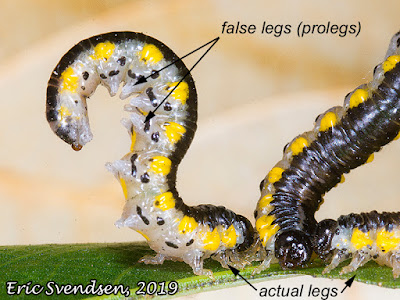Leaf-rollers
 |
| Leaf-roller tube and exposed caterpillar |
These caterpillars belong to a family of moths called, appropriately enough, leaf-rollers. There are quite a few species, and some of them are significant pests. Eggs are laid by the adult moths on branches in the fall. They overwinter and in the spring the larvae emerge. Some have a diet which is very specific, and they will eat only the leaves of certain plants. This is where the pest component comes in. There are blueberry, cherry, pear, almond, and other fruit tree leaf-rollers. Other leaf-rollers are less specific in their tastes and will feed on a wide variety of crops.
It is fascinating to watch a leaf-roller construct its domicile. If you click on the youtube link below, it will take you to video showing how one species goes about it. Caterpillars produce silk from modified saliva glands located in their mouths. Leaf-rollers will attach a strand of silk to one side of a leaf and stretch the strand over to the other side multiple times. The strands slowly contract and bring the leaf together to form a tube. As the tube starts to form the process continues to make it secure. They are then in a position to feed safely in their protective case.
Certain ichnumid wasps will lay their eggs on the growing caterpillar. The eggs hatch and the young wasp larva burrows into its host and starts to feed. The caterpillar goes on with its business. The eerie parasite / host relationship goes on until the ichnumid larvae mature. At this point they leave the body of the caterpillar, which results in its death. The second youtube link shows the similar process in a different species of caterpillar. Be warned though, it is a little unsettling, but definitely cool.
Isn't nature amazing!
https://pnwhandbooks.org/insect/hort/landscape/common/landscape-leafroller-leaftier
https://www.youtube.com/watch?v=ccpDJvGMVuw Leaf roller video
https://www.youtube.com/watch?v=vMG-LWyNcAs Ichnumid wasp video (kind of gross!)



Comments
Post a Comment